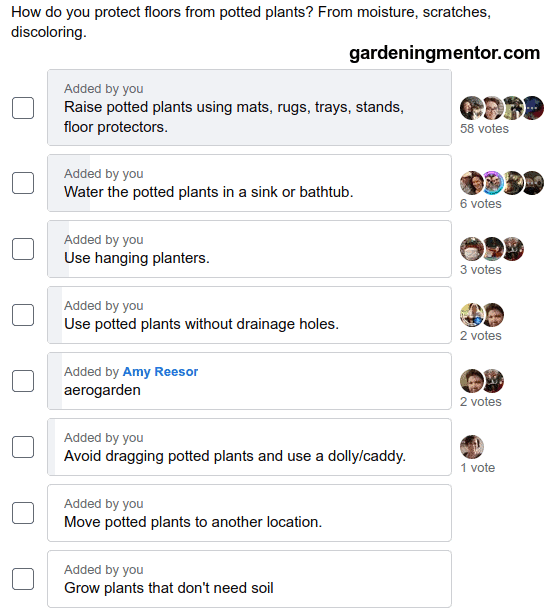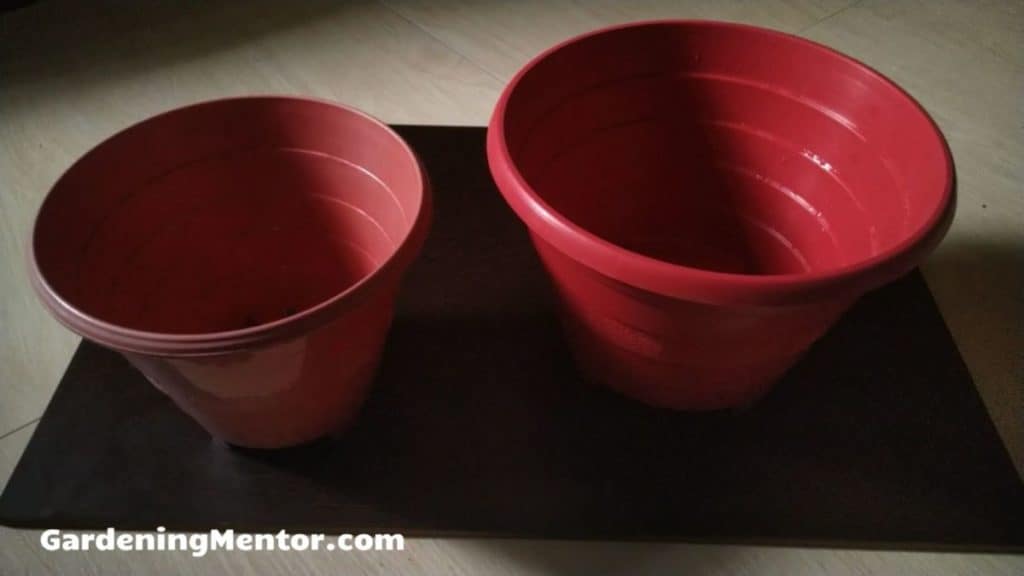What is that?
You see stains on your wooden floor when you moved the potted plant. What did that happen?
In this post, I’ll help you with 10 awesome tips that will help you protect your floor from the problems that potted plants may create.
Let’s get started.
Protect your floor from potted plants by using cork coasters, plastic trays, metal stands, pot risers, plant mats, or rugs. Water the potted plants in the sink instead of the floor. Use hanging planters that are above the floor.
1. Raise the potted plants above the floor
The major problem your floor will face is from the moisture seeping out of the drainage holes of potted plants. If your floor is made of wood, it may start to rot. If your floor is made from material like ceramic, it will stain.
The simplest solution is to raise the potted plants above the floor so you can get a chance to wipe off the excess moisture.
There are several options you can use to raise potted plants above the floor.
Cork plant mats
You can put a cork plant mat under indoor plants to avoid them touching the floor. They do not absorb moisture and will protect the floor.
You could drag the potted plants over the cork plant mats without issues. Cork is a soft material that will prevent scrapes on your floor.
Rugs
If you have no other choice but to put the pot on the floor, then try using a rug. You can buy a rug specifically for pots. This way, the water will be absorbed by the rug instead of flowing over the floor.
You will need to often dry the rug and wash it. Otherwise, you may risk damaging the floor and even causing issues like mildew or mold.
I just find a saucer or similar thing to put under pots. I’m always saving plastic food lids, because they are often the perfect size. Recently I have also started using the bottom 1/8th of milk jugs as plant saucers, because I am using the tops for cloches when spring comes around. They also work pretty well, although they aren’t flat which can be an issue. – Owen
You can keep a tray or saucer below the potted plant. The water from the drainage holes will collect in this tray and not touch the floor.
You should check the tray periodically and throw the water away. Otherwise, the water will flow out of the tray and affect the floor.
Stands
Putting your potted plant on a stand is also a good option to keep it away from the floor. The water will still seep out from the drainage holes, but at least you can clean it off the floor immediately and protect it.
You could also use a stand along with a tray to keep the water from reaching the floor.
Floor protectors
Plant floor protector is a great option to keep dirt and moisture away from the floor. You can get these in different materials, such as plastic, vinyl, or rubber.
You just place this indoor plant floor protector on the floor and put your potted plant on it. They will also protect your floor from scratches that may occur when you move the potted plants.
Pot risers
Pot risers are small pieces made from recycled rubber that will lift the potted plant 1/2-inch to 3/4th-inch above the floor.
They help protect the floor from stains caused by the water draining out of the potted plants. They will also protect against scratches that the potted plant may cause.
I took a survey of fellow gardeners on how they protect their floors from potted plants. Below is the result of this poll that may benefit you. Most people thought it’s a good idea to raise potted plants above the floor.

2. Use a larger pot to collect the water
You can keep a smaller plant pot inside a larger pot that does not have drainage holes. The water from the smaller pot will collect in the larger pot that you can periodically throw away.
The benefit of this method is you can grow plants in small plastic pots and put them in larger pots such as ceramic ones that have better aesthetic appeal.

3. Water the potted plants away from the floor
This is one of the best ways to protect your floor, even if your potted plants have drainage holes. You take the potted plants to a sink or bathtub and water them.
The water drains out from the drainage holes into the sink or bathtub. Once the watering is done, you can move the potted plants back to their location.
You can use either top watering or bottom watering when you take your plants to the sink or bathtub.
This method only works for small pots that you can carry over to the sink or bathtub. You don’t want to strain yourself attempting to carry huge pots.
This is also a time-consuming method if you have many potted plants you need to water often.
4. Move potted plants to new locations regularly
If you keep watering potted plants kept at the same location, the water draining out of the pot will accumulate on the floor. Over time, this moisture will damage your floor, whether it’s made from wood or ceramic.
It’s good if you regularly move potted plants to new locations. This will prevent the moisture from causing major damage to one location of the floor.
It will also give you an opportunity to clean the moisture from the floor at the spot where the potted plant was growing.
5. Avoid dragging potted plants across the floor
You want to move potted plants either to a new location or to water them over the sink or bathtub. But moving pots can cause harm to the floor when you drag them as they cause scratch marks.
I suggest either using small pots that you can carry over to the other location. Or use a dolly with rubber-wheels to move larger pots.
Pots on an old floor tile on top of an appropriate sized dolly. This works great for my 15 gallon grow bags, I use a 20”x20” tile! They roll to the sun! – Mary
6. Make sure the potted plants are secure
The potted plants can harm floors if they fall over and cause scratches. This may happen either due to wind or having kids/pets in your home.
So make sure to secure the potted plants to avoid this problem. You can use heavy pots that are difficult to move around. Pots made with ceramic, metal, or wood might be suitable. Or you can use plastic pots that will be harmless even if they fall over.
7. Use potted plants that don’t have drainage holes
If you want to avoid moisture from potted plants affecting the floor, you could think about using pots that don’t have drainage holes.
You will need to be super careful to avoid overwatering because excess water will cause root rot and kill the plants.
One option is to use self-watering containers that will prevent water flowing out on to the floor. And also has the benefit you don’t need to water your potted plants as often.
The self-watering container has a reservoir at the bottom that is used to water the plants. You fill the reservoir with water and the soil absorbs the required moisture.
8. Use hanging planters to avoid touching floors
If you have the space indoors or outdoors, you can consider using hanging planters. If you put them outside, then you can keep them away from the floors.
If you put the hanging planters indoors, you have a better chance of cleaning the moisture that hits the floor before it can create a problem.
You could also use a hanging planter with a tray so you can collect water from the drainage holes and throw it away without reaching the floor.
If they are small enough, shelf or plant stand, hanging works too. All my plants have a tray or second pot to catch the extra water. If they are big, put them on a rolling stand. – Kate
9. Grow plants that don’t require soil
You can avoid moisture causing problems to the floor by growing plants that don’t need soil and hence drainage holes. These are plants that can grow in water such as lucky bamboo, Spanish moss, and philodendron.
You only need to replace the water in the pot every period so the plants can get fresh water and nutrients. You should also clean the pots every few days to prevent problems such as algae growth.
10. Protect the floor from soil
Soil can also harm the floor, causing stains and entering crevices. You want to prevent over-filling the pot where the soil may flow out during watering.
Make sure the soil level is 2-inches below the rim of the pot. This helps keep the soil inside when you water the potted plant.
The soil may also leach out from the drainage holes at the bottom if the holes are big. You want to add organic material such as broken terracotta pieces, newspaper, straw, dried leaves at the bottom of the pot before you add the potting soil.
How to water indoor plants without making a mess
Bottom watering is a good choice if you want to avoid a mess when watering indoor plants. You place the plant pot in a tray and add water to the tray. The soil will soak water from the drainage holes. So the water will not spill on the floor or furniture. You need to check the soil moisture before adding the water to the tray to avoid overwatering.

Fact Checked, Written, and Published by Kevin Rodrigues
Kevin is the founder of Gardening Mentor, a website that aims to teach people to grow their own food in a limited space. As a self-taught gardener, Kevin has spent several years growing plants and creating gardening content on the website. He is certified in Home Horticulture and Organic Gardening from Oregon State University. He has a Post Graduate Diploma in Horticulture and Landscape Gardening from Mumbai University.
Read more
